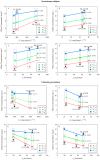An Insight into the Combined Toxicity of 3,4-Dichloroaniline with Two-Dimensional Nanomaterials: From Classical Mixture Theory to Structure-Activity Relationship
- PMID: 36835146
- PMCID: PMC9959308
- DOI: 10.3390/ijms24043723
An Insight into the Combined Toxicity of 3,4-Dichloroaniline with Two-Dimensional Nanomaterials: From Classical Mixture Theory to Structure-Activity Relationship
Abstract
The assessment and prediction of the toxicity of engineered nanomaterials (NMs) present in mixtures is a challenging research issue. Herein, the toxicity of three advanced two-dimensional nanomaterials (TDNMs), in combination with an organic chemical (3,4-dichloroaniline, DCA) to two freshwater microalgae (Scenedesmus obliquus and Chlorella pyrenoidosa), was assessed and predicted not only from classical mixture theory but also from structure-activity relationships. The TDNMs included two layered double hydroxides (Mg-Al-LDH and Zn-Al-LDH) and a graphene nanoplatelet (GNP). The toxicity of DCA varied with the type and concentration of TDNMs, as well as the species. The combination of DCA and TDNMs exhibited additive, antagonistic, and synergistic effects. There is a linear relationship between the different levels (10, 50, and 90%) of effect concentrations and a Freundlich adsorption coefficient (KF) calculated by isotherm models and adsorption energy (Ea) obtained in molecular simulations, respectively. The prediction model incorporating both parameters KF and Ea had a higher predictive power for the combined toxicity than the classical mixture model. Our findings provide new insights for the development of strategies aimed at evaluating the ecotoxicological risk of NMs towards combined pollution situations.
Keywords: aquatic toxicity; combined pollution; in silico; multifunctional nanomaterials; structure-activity relationship.
Conflict of interest statement
The authors declare no conflict of interest.
Figures




Similar articles
-
Dissolved Organic Matter and Lignin Modulate Aquatic Toxicity and Oxidative Stress Response Activated by Layered Double Hydroxides Nanomaterials.Arch Environ Contam Toxicol. 2023 Apr;84(3):413-425. doi: 10.1007/s00244-023-00985-4. Epub 2023 Feb 15. Arch Environ Contam Toxicol. 2023. PMID: 36790502
-
Chemical- and species-specific toxicity of nonylphenol and octylphenol to microalgae Chlorella pyrenoidosa and Scenedesmus obliquus.Environ Toxicol Pharmacol. 2021 Jan;81:103517. doi: 10.1016/j.etap.2020.103517. Epub 2020 Oct 17. Environ Toxicol Pharmacol. 2021. PMID: 33080356
-
Factors affecting the toxicity and oxidative stress of layered double hydroxide-based nanomaterials in freshwater algae.Environ Sci Pollut Res Int. 2023 May;30(22):63109-63120. doi: 10.1007/s11356-023-26522-3. Epub 2023 Mar 23. Environ Sci Pollut Res Int. 2023. PMID: 36959400
-
A critical review on the interaction of polymer particles and co-existing contaminants: Adsorption mechanism, exposure factors, effects on plankton species.J Hazard Mater. 2023 Mar 5;445:130463. doi: 10.1016/j.jhazmat.2022.130463. Epub 2022 Nov 23. J Hazard Mater. 2023. PMID: 36463745 Review.
-
Layered double hydroxides and related hybrid materials for removal of pharmaceutical pollutants from water.J Environ Manage. 2021 Jun 15;288:112399. doi: 10.1016/j.jenvman.2021.112399. Epub 2021 Mar 26. J Environ Manage. 2021. PMID: 33774560 Review.
Cited by
-
Joint Toxicity and Interaction of Carbon-Based Nanomaterials with Co-Existing Pollutants in Aquatic Environments: A Review.Int J Mol Sci. 2024 Nov 2;25(21):11798. doi: 10.3390/ijms252111798. Int J Mol Sci. 2024. PMID: 39519349 Free PMC article. Review.
-
The Silent Threat: Exploring the Ecological and Ecotoxicological Impacts of Chlorinated Aniline Derivatives and the Metabolites on the Aquatic Ecosystem.J Xenobiot. 2023 Oct 1;13(4):604-614. doi: 10.3390/jox13040038. J Xenobiot. 2023. PMID: 37873815 Free PMC article.
References
-
- Tschiche H.R., Bierkandt F.S., Creutzenberg O., Fessard V., Franz R., Greiner R., Gruber-Traub C., Haas K.H., Haase A., Hartwig A., et al. Analytical and toxicological aspects of nanomaterials in different product groups: Challenges and opportunities. NanoImpact. 2022;28:100416. doi: 10.1016/j.impact.2022.100416. - DOI - PubMed
MeSH terms
Substances
Grants and funding
LinkOut - more resources
Full Text Sources

